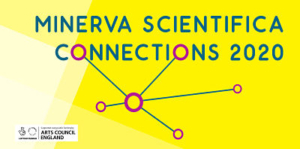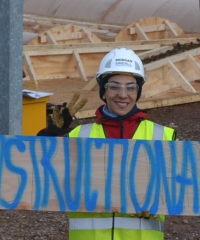Dr Maryam Imani
Civil Engineer (Water Systems Engineer)
A Construction site for our ARU course ‘constructionarium’ – the photo was taken in Women in Engineering Day in 2018 (All images kindly provided by Maryam)
- BORN 1977, Karaj, Tehran, Iran
- WORKED Anglia Ruskin University; University of Exeter; Institution of Civil Engineers; ICE Essex Committee
- HONOURS ICE STEM Ambassador of the Year award, May 2020; ‘Frontiers of Engineering for Development’ Award (Royal Academy of Engineering), Dec 2016; ‘NSF-EPSRC: Clean Water for All’ Award, Jan 2015; Exeter Research Scholarship (ERS) Award, Sep 2008; Charted Civil Engineer, Oct 2007
- MINERVA SCIENTIFICA PROJECT Echoes from Essex 2020


PODCAST
On 23 June 2020 we celebrated International Women in Engineering Day through the “Echoes from Essex” project in collaboration with Chelmsford Civic Theatre. We asked 6 engineers from Essex, past and present—including Dr Maryam Imani—to describe their work through the 5 senses. Their responses draw us into an unexpectedly diverse world of women in engineering. For more Minerva Scientifica podcasts click here.
Artistic Connections
No connections – apart from being involved with Minerva Scientifica – Echoes from Essex.
MUSIC
Title: Echoes from Essex
Composer: FRANCES M LYNCH
Words by: Frances M Lynch
Written in: August 2020
For: Mixed Chorus, Piano, Harpsichord, Bass Viol, 2 Solo Violins, Orchestra
Performed by: Essex Virtual Choir
First Performed: by Essex Virtual Choir on September 20th at the “Hope for Essex” performance on Zoom in collaboration with Chelmsford Civic Theatres and Essex Music Education Hub
This is the signature tune of the “Echoes from Essex” project in which Dr Maryam Imani took part. It highlights the lives of our featured historical Essex Women in STEMM and celebrates those who are building the future world now. The project ran from July – October 2020.
Thanks are due to Dr Patricia Fara whose historical research inspired the text for this song and formed the basis for the whole project.
You can download the full text here.
Please visit our Essex Virtual Choir page where you can click through to the resources page for the score and learning recordings.

Hydraulics Lab – Impact of a Jet apparatus – to test Newton’s 2nd law
Education
Primarily I did not intend to become an engineer. In fact, I wanted to become a pilot, but the Lego that I received for my seventh birthday was a game changer. Making buildings, structures, roads and bridges fascinated me (and still does). Eventually, my passion for maths, geometry and algebra, throughout my school time, helped me to make up my mind for Civil Engineering. I did my undergraduate in Civil Engineering and progressed to my postgraduate in Water Systems Engineering. My academic education journey finally completed with a PhD degree in Water Systems Engineering from the University of Exeter in Devon. Following that, I held a postdoctoral position at the University of Exeter working on several engineering research projects. This was the start of my journey to becoming a scientist in Civil Engineering trying to make life better for people around the world with my cutting-edge research.
Occupations
Senior Lecturer in Water Systems Engineering
Department of Engineering & the Built Environment, Anglia Ruskin University, 2015 – Present
Associate Research Fellow
(ARF) Safe & SuRe Water Management Project, Centre for Water Systems, University of Exeter, May 2013- 15

An open day at ARU – Geotechnic lab
Visiting Research Fellow
Urban Water Research Group, University of Utah, US
Associate Lecturer
INTO University of Exeter, Jan – May 2013
Civil Engineer
in Tehran Municipality, Jan 2008 – Sep 2012
Water Systems Engineer
Pars Consult (Reyab water consultant) company, Jun 2007 – Jan 2008
Research Engineer
University of Tehran, Oct 2004-7, Associate Lecturer Tehran Institute of Technology, Oct 2004-5
Technical Director & Executive Engineer
Lajvardpey Construction Company, 2001-3

Hydraulics Lab – Flume apparatus – Hydraulics Jump experiment
Scientific Achievements
I am a Senior Lecturer in Civil Engineering and a scientist in water and wastewater (W&W) infrastructure systems in the School of Engineering and the Built Environment at Anglia Ruskin University. I am also a member and School Liaison Officer (SLO) of the Institution of Civil Engineers (ICE) Essex Committee and an ICE STEM ambassador. My research focuses on development of models & strategies to improve resilience of assets in W&W infrastructure systems to emerging challenges. In simpler terms, I create computer models of W&W systems to translate nature laws and phenomena into commands that operate systems.
Climate change, developments, urbanisation, population growth and so on, collectively put growing pressure on critical infrastructures (CI) such as water and wastewater systems, transport systems (roads, rails etc), and energy systems. These challenges lead to increased costs to maintain the business-as-usual operation of these systems. Promoting CI resilience will support the utility sector and communities to cope with impacts of unexpected challenges such as the COVID-19 pandemic. Resilience of water and wastewater infrastructure is an integral part of the built environment, and is at the heart of the UK Government’s Natural Infrastructure Plan. And yet, an integrated and unified system or tool that can be used to promote water infrastructure resilience does not exist, and scientists are still exploring how best they can achieve that. This is where Civil Engineering comes in. It is so much more than the way Civil Engineers are portrayed wearing hard hat and working on construction site, although this image is true to an extent.
Hence, any research (including mine) on infrastructure design and performance modelling and optimisation can support utility sectors, infrastructure operators, the government and ultimately society to tackle the consequences of future challenges.

Hydraulics Lab – Flume apparatus – Data Collection
Did You Know?
I am:
- Adaptable and flexible (sometimes I feel it’s too much)
- A challenge seeker
- Persistent when a male colleague believe I can’t do it or it’s not my job
- Moody sometimes
AN INSPIRING WOMAN
Surprisingly, I have never had any particular female role models, not because there weren’t any, but because I admire all the women in engineering that serve their communities regardless of discrimination, barriers, stereotypes and glass ceilings. I learned different things from different women. My parents were my rock, and were so excited to have a Civil Engineer daughter. My Geometry and Maths teacher with his passion for colourful chalks. And profs. Dragan Savic Zoran Kapelan at the University of Exeter. They were my inspiration, true legends. Their dedication, hard work and commitment to their profession, society and their families are exemplar.

